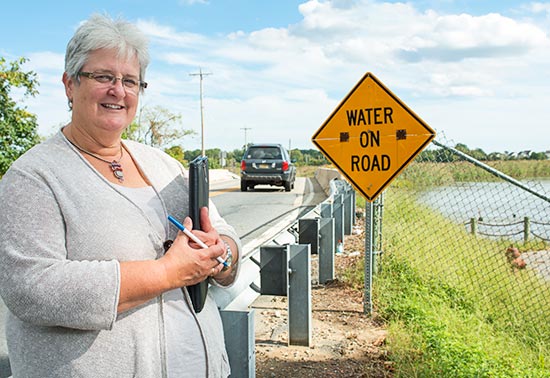



By karen roberts College of Engineering

Small changes in temperature (0.2°C per decade) and widespread snow melt are leading to extreme changes in sea level rise across the world. In the U.S. Mid-Atlantic region, climate change means increased hot days and heat waves, rising sea levels and increased frequency of intense precipitation events.
For transportation planners, this is particularly concerning in coastal regions where roadway flooding often follows volatile precipitation events. In other areas, storm surge combined with climate change can impact low-lying roads and rail lines. Because changes occur gradually over time, there is seldom an urgency to act.
Sue McNeil, director of UD’s University Transportation Center (UD-UTC), has spent the last five years contemplating how Delaware, and the nation, can best adapt transportation planning measures to overcome risks associated with sea level rise and climate change.
The UD-UTC is a Tier II University Transportation Center organized within the Delaware Center for Transportation (DCT). The UD center serves as a resource to the state and nation for data and tools to understand and improve our transportation corridors’ resiliency to short- and long-term pressures like climate change. Center research ranges from advanced pavement designs and materials that can adapt to temperature and saturation changes, to cost-effective ways to salvage roads or make them less vulnerable.
A UD professor with more than 25 years’ experience in infrastructure management, McNeil became interested in the issue in 2008, when she developed a white paper for the Transportation Research Board (an arm of the National Academy of Sciences) detailing research needs for climate change adaption as it relates to transportation.
She reviewed work from around the globe, including the United Kingdom, Australia and New Zealand, where transportation agencies recognize research linking climate change, asset management and sustainability. She subsequently participated in national studies on the effect to highway systems and transportation infrastructure and conducted local research on specific impacts to the I-95 corridor in Maryland and Delaware.
“Each time I drive I-495 along the Delaware River, I think about what impact adding half a meter of sea level rise and a large storm could have on our roads,” she says.
According to McNeil, transportation planning that integrates climate change is necessary to avoid compounding problems in the future. In practice, roads and bridges are designed with a lifespan of 25 years, but states often try to eke out 30, 40 or 50 years, making strategic upgrades that add strength to the road structure, as advanced materials and techniques come to market.
Planning ahead is particularly important along the I-95 corridor because all modes of transportation are at risk—from major thoroughfares to rail lines—especially along minor coastal roads near the Delaware Bay. Important transportation planning considerations should include road adaptation, reducing vulnerability and mitigating recurrent problems.
“We must always ask what happens under climate change because it is sea level rise on top of heavy storms that becomes the real problem in the short term and causes recurrent long-term problems,” she says.
According to McNeil, Delaware is ahead of its peers when it comes to sea level rise. While the UD-UTC winds down, the DCT is gearing up, working with regional planning groups such as the Wilmington Area Planning Council and the Delaware Department of Transportation, which mirror the UD-UTC’s efforts on a larger scale.
McNeil also would like to create a database to record how many events occur in Delaware annually, taking into account how frequently roads are rebuilt and taking advantage of prediction modeling techniques to estimate future effects. Future projects, she says, could include decision models and policies for vulnerable roads and highways that are regularly inundated by weather.
In essence, she would like to create a road map—one that will help lead Delaware toward a sustainable transportation future.